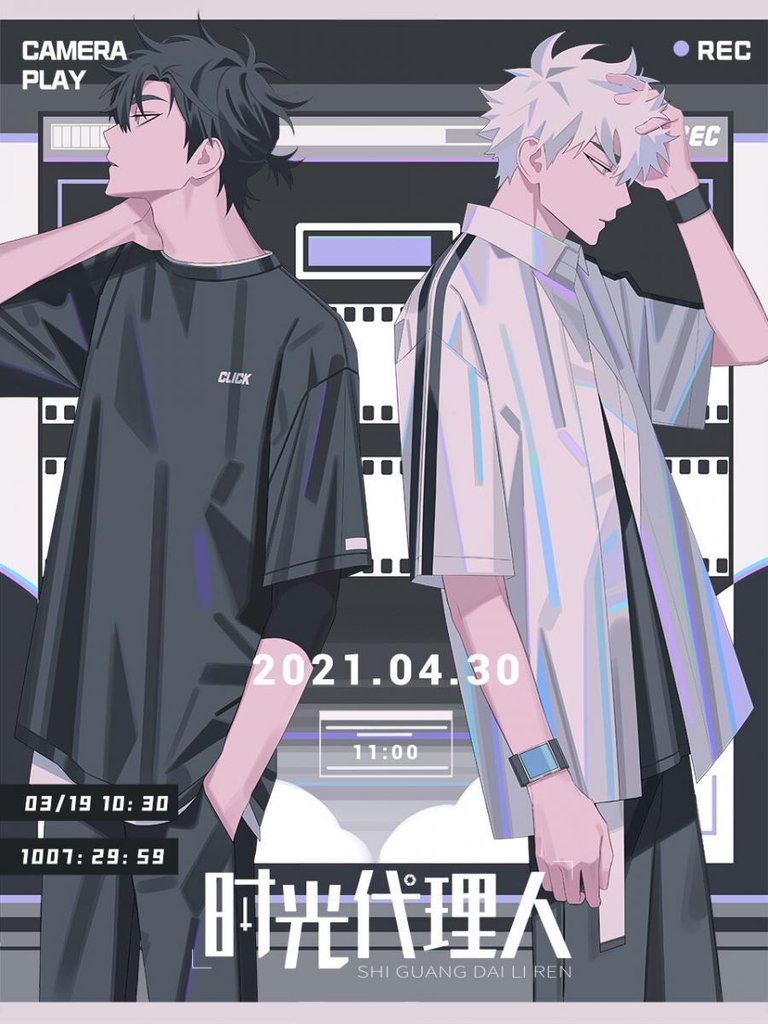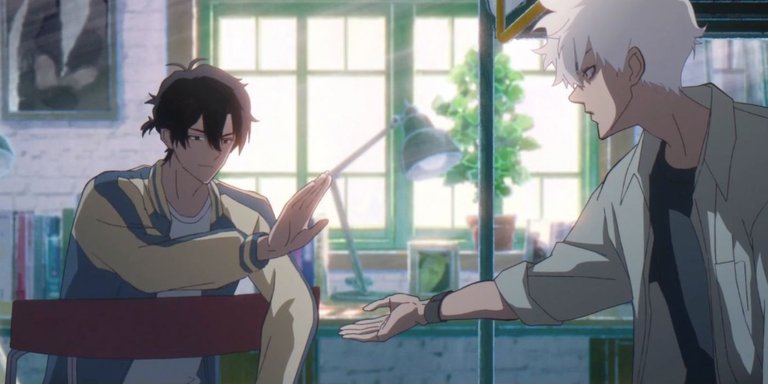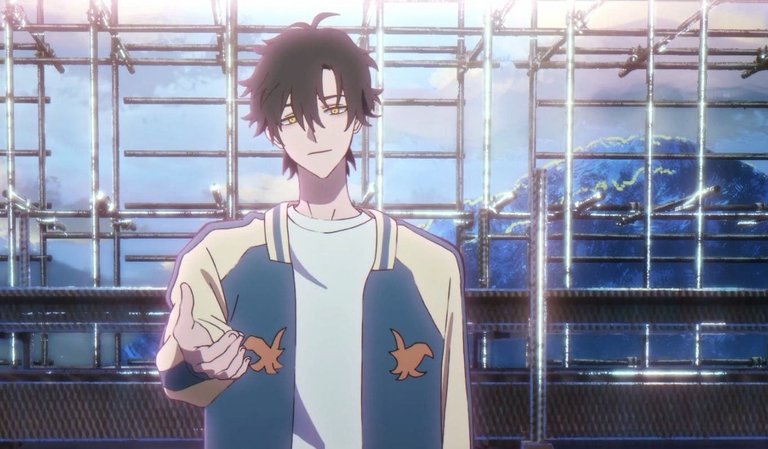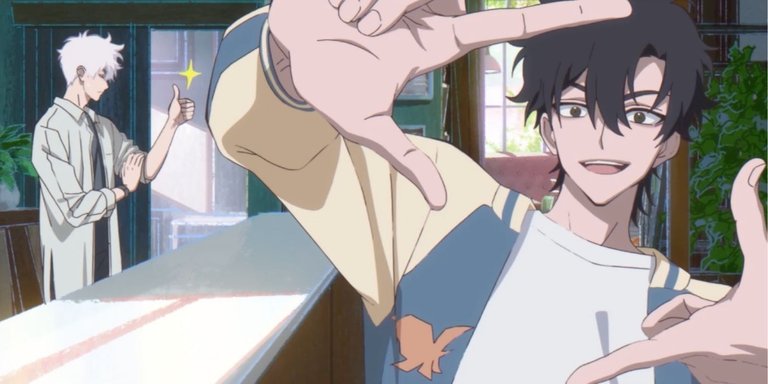
Cover Image
VERSIÓN EN ESPAÑOL (click aquí)
Buenos días, buenas tardes y buenas noches. ¿Cómo están? ¿Cómo se encuentran? Espero que muy bien en este maravilloso día. Hoy estoy aquí ante ustedes porque quiero enseñarles un gran descubrimiento, algo que, muy dentro de mí, había estado buscando pero que no había podido encontrar en ningún lado, hasta que me llegó la recomendación ideal desde el cielo, gracias a una amiga.
¿Qué es lo que andaba buscando? Te preguntarás, y yo fácilmente te responderé, mi amiguito: quería conocer la animación china, pero no había tenido la oportunidad como tal, y lo que encontraba no era lo que buscaba. Eran caricaturas más al estilo occidental y no al estilo anime. Ahora es muy popular que adapten manhwas, pero usualmente lo hacen los estudios japoneses. Los chinos, al ser más independientes, tendrían que hacerlo por sí mismos, pensé, y no estaba equivocado.
Lo que no esperaba es que lo exportaran con doblaje en japonés; pensaba que lo enviarían con subtítulos nada más, pero bueno, eso es otro tema. Me vi la primera temporada en japonés y la segunda en chino.
Lo que me convenció definitivamente de ver Link Click es que la animación parecía un anime y que la trama tenía que ver con viajes en el tiempo. Obviamente, si es la primera vez que me lees, no lo sabrás, pero pienso que son las mejores historias si se hacen de buena manera. Ya sabes, en algunas obras la forma en que lo implementan no tiene sentido, pero si estás leyendo esto, es porque, evidentemente, aquí son buenos.
Así que, sin más dilación, adentrémonos en la historia de Link Click.
Good morning, good afternoon, and good evening. How are you? How are you feeling? I hope you're doing splendidly on this wonderful day. Today I'm here before you because I want to share a marvellous discovery - something I'd been searching for deep within myself but hadn't been able to find anywhere, until heaven-sent recommendation came my way thanks to a friend.
"What was I looking for?" you might wonder, and I'll tell you straight away, my dear friend: I wanted to explore Chinese animation, but hadn't had the proper opportunity, and what I kept finding wasn't what I was after. They were cartoons more in the Western style rather than proper anime. Nowadays it's quite popular to adapt manhwas, but usually it's Japanese studios doing it. The Chinese, being more independent, would have to do it themselves, I thought - and I wasn't wrong.
What I didn't expect was for it to be exported with Japanese dubbing; I assumed they'd just release it with subtitles, but oh well, that's another matter. I watched the first season in Japanese and the second in Chinese.
What ultimately convinced me to watch Link Click was that the animation looked like proper anime and the plot involved time travel. Obviously, if this is your first time reading me, you wouldn't know this, but I believe these make for the best stories when done properly. You know how in some works the way they implement it makes no sense? But if you're reading this, it's because clearly, here they've done it right.
So without further ado, let's delve into the story of Link Click.

Source
VERSIÓN EN ESPAÑOL (click aquí)
Link Click nos narra la historia de dos chicos, Cheng Xiaoshi y Lu Guang (aunque creo que en japonés tienen otros nombres). Los cuales trabajan juntos en un estudio de fotografía, este siendo propiedad de Xiaoshi al haber sido heredado de sus padres. Junto a ellos también está su cobradora Qiao Ling, aunque en realidad es más como una hermana para Xiaoshi, ya que lo ha acompañado desde pequeño en las buenas y en las malas (no quiero dar muchos detalles porque les arruinaría la trama).
Hasta este punto de la descripción, probablemente te estés haciendo la pregunta: "¿Me estaré equivocando de historia? ¿Dónde encajan los viajes en el tiempo en un simple estudio de fotografía?" Pues el giro argumental viene justo aquí, cuando descubrimos que el servicio fotográfico que ofrecen Xiaoshi y Lu Guang está muy lejos de ser convencional. Ambos poseen habilidades especiales que, al combinarse, les permiten literalmente cambiar el pasado.
Ellos reciben encargos a través de su mánager, la ya mencionada Qiao Ling. Estos casos, en su gran mayoría, consisten en aliviar alguna carga emocional del cliente o cumplir algo que el cliente hubiera querido hacer pero que las circunstancias no le permitieron en su momento.
Ahora sí, entrando en detalles: Xiaoshi tiene la capacidad de introducirse en las fotografías, viajando al momento exacto en que estas fueron tomadas y poseyendo temporalmente a la persona que tomó dicha foto. Por su parte, Lu Guang actúa como su guía y ancla, ya que puede ver todo lo que ocurrirá en las 12 horas siguientes al momento en que se tomó la fotografía. Además, debe mantener bajo control a su mejor amigo Xiaoshi, quien es bastante impulsivo. Hay reglas estrictas que no pueden romperse bajo ninguna circunstancia, pues de hacerlo, el futuro cambiaría drásticamente, muchas veces con resultados trágicos.
Esto nos da como resultado una fascinante historia de misterio que te mantiene pegado al asiento, siempre preguntándote qué terribles consecuencias podrían desencadenarse con cada viaje al pasado...
Link Click tells the story of two lads, Cheng Xiaoshi and Lu Guang (though I believe they have different names in the Japanese version). They work together in a photography studio owned by Xiaoshi, having inherited it from his parents. Alongside them is their debt collector Qiao Ling - though she's more like a sister to Xiaoshi, having stood by him through thick and thin since childhood (I shan't spoil too many details as it would ruin the plot for you).
At this point in the description, you're likely wondering: "Am I misunderstanding the premise? How does time travel fit into a simple photography studio?" Well, here's where the plot twist comes in - the photographic service Xiaoshi and Lu Guang offer is far from ordinary. Together they possess special abilities that literally allow them to alter the past.
They receive commissions through their manager, the aforementioned Qiao Ling. Most cases involve either easing a client's emotional burden or fulfilling something the client wished to do but couldn't due to circumstances at the time.
Now, let's get into the specifics: Xiaoshi can physically enter photographs, travelling back to the exact moment they were taken and temporarily possessing the person who took the photo. Meanwhile, Lu Guang serves as his guide and anchor, able to see everything that will occur in the 12 hours following when the photograph was taken. He must also keep his rather impulsive best friend Xiaoshi in check. There are strict rules that cannot be broken under any circumstances - doing so would drastically alter the future, often with tragic consequences.
The result is a gripping mystery thriller that keeps you on the edge of your seat, constantly wondering what terrible repercussions might unfold with each journey into the past...

Source
VERSIÓN EN ESPAÑOL (click aquí)
La primera temporada de Link Click fácilmente se podría considerar como una introducción a la historia. Técnicamente no se nos explica mucho acerca de los personajes y sus motivaciones; nos centramos más en los casos que llegan a la tienda de fotografía. Algunos de ellos son bastante buenos y, personalmente, me conmovieron, como el caso del basquetbolista o el señor mayor que, para poder casarse con su amada, debe vencer a su padre, el cual es un experto en karate.
De verdad te llena el corazón ver que, de alguna forma u otra, pudieron ayudar a esas personas a reconciliarse consigo mismas. Hay casos especiales donde también se solicita el servicio de manera egoísta, pero que al descubrir lo que de verdad estaban buscando, terminan reflexionando acerca de sus acciones - me refiero al caso de la receta de los fideos.
Aunque no todo será color de rosas. De fondo, mientras vemos transcurrir todos esos servicios, un asesino en serie estará actuando. Lo peor es que parece tener habilidades como las de los protagonistas, lo cual te volará la cabeza, porque se abre un mundo nuevo de posibilidades. Pero realmente todo esto se aborda bien en la temporada dos, donde vemos el enfrentamiento y persecución contra el artífice de lo malo que ha estado ocurriendo. En la temporada uno solo se da un abrebocas.
Luego también está la temporada tres, que sinceramente es la cosa más confusa del mundo y aún no ha terminado, así que no emitiré opiniones.
The first season of Link Click could easily be considered an introduction to the story. Technically speaking, we're not told much about the characters and their motivations; the focus is more on the cases that come into the photography shop. Some of these are rather good and personally moved me - like the basketball player's story or the elderly gentleman who, in order to marry his beloved, must defeat her father, who is a karate expert.
It truly warms your heart to see how, in one way or another, they managed to help these people make peace with themselves. There are special cases where the service is requested for selfish reasons too, but upon discovering what they were truly searching for, the clients end up reflecting on their actions - I'm referring to the noodle recipe case here.
Though it's not all sunshine and roses. In the background, as all these services unfold, a serial killer is at work. The worst part? He appears to have abilities like our protagonists', which will absolutely blow your mind as it opens up a whole new world of possibilities. But this is properly explored in season two, where we see the confrontation and pursuit of the mastermind behind all the bad things that have been happening. The first season just gives us a taste.
Then there's season three, which frankly is the most confusing thing ever and still isn't finished, so I shan't offer any opinions on that.

Source
VERSIÓN EN ESPAÑOL (click aquí)
La animación, sin lugar a dudas, es algo espectacular, digno de ver y no le envidia nada a lo que es la animación japonesa. En la segunda temporada se pueden ver algunos combates cuerpo a cuerpo que son un verdadero lujo; empiezo a creer que son especialistas en eso, porque hace muchos años se hizo bastante popular las escenas de pelea de un anime de allá, aunque nunca conseguí el nombre para verlo.
Creo que lo único que podría llegarme a disgustar es el formato de pantalla que utilizan: siempre la estuve viendo con franjas negras arriba y abajo, lo cual es extraño porque en el capítulo especial de la temporada 3 usan un formato normal.
Los personajes son bastante buenos; quieres saber sus orígenes, cuáles son sus motivaciones y demás. Todo está envuelto en ese aura de misterio que hace que cada capítulo te atrape. Si la ves, fácilmente te harás un maratón.
Un inconveniente que quizás pueda encontrar el público en general es que se les pueda hacer incómodo el idioma chino, porque hablan con una entonación muy fuerte y pareciera que estuvieran gritando. Esto se nota más cuando vienes acostumbrado a escuchar nada más que japonés o coreano, aunque esto es más cuestión de costumbre: después de un par de capítulos se te pasa.
Si llevas tiempo sin ver una buena obra de viajes en el tiempo, te recomiendo esta al cien por ciento. Solo te aviso de antemano que vas a tener que pensar mucho para entender todo lo que está ocurriendo en pantalla, y quizás hasta tengas que volver a ver algunos capítulos, jajaja.
The animation is, without a doubt, absolutely spectacular - truly worth watching and in no way inferior to Japanese animation. In the second season, there are some hand-to-hand combat sequences that are proper luxury; I'm beginning to think they must specialise in this, because years ago the fight scenes from some anime over there became quite popular, though I never managed to catch its name.
If I had to pick one thing that might bother me, it would be the screen format they use: I've always watched it with black bars at the top and bottom, which seems odd because the special episode in season 3 uses a normal format.
The characters are rather brilliant - you find yourself wanting to know their backgrounds, motivations and all that. Everything's wrapped in this aura of mystery that makes each episode utterly gripping. If you start watching, you'll easily end up binge-watching the lot.
One issue general audiences might have is potentially finding the Chinese language a bit jarring, as they speak with rather strong intonation that makes it seem like they're shouting. This stands out more when you're accustomed to only hearing Japanese or Korean, though it's really just a matter of getting used to it - after a couple episodes you won't even notice.
If it's been ages since you've seen a good time-travel story, I'd recommend this one 100%. Just fair warning - you'll need to pay proper attention to understand everything happening on screen, and you might even have to rewatch some episodes, hahaha.
Studio: Studio LAN
Traducido con DeepSeek / Translated with DeepSeek
A time travel anime? I just hope they make sense, not like in Charlotte.
That comparison was painful even for me.
Hello @syberia! The Anime Realm team here 😊.
We want to thank you for choosing this community to publish your manga and anime related content.
Don't forget to check the rules and the suggested community guidelines post. Also, always keep in mind the importance of visiting and supporting other users' posts, those will allow us to keep growing as users and as a community.
We hope to see you soon. Greetings!
Me encaaaantan los personajes de este anime 😭✨ Buen post!
Lo admito, a mí también me encantan mucho, en específico el dúo protagonista, al punto que llegué a decir para mí mismo varias veces: ¡que vivan los novios! Ksjsk
Ow i remember starting this anime but i just watched the first two episodes, i guess you've encouraged me to go back to t.
You need to watch the whole thing, it’s really good.
Thanks for this...
I've been looking for what to start in a while and it seems I've seen it✨😂🔥
@syberia, I paid out 0.437 HIVE and 0.087 HBD to reward 1 comments in this discussion thread.
If you love time-travel stories, you’re sure to adore it.